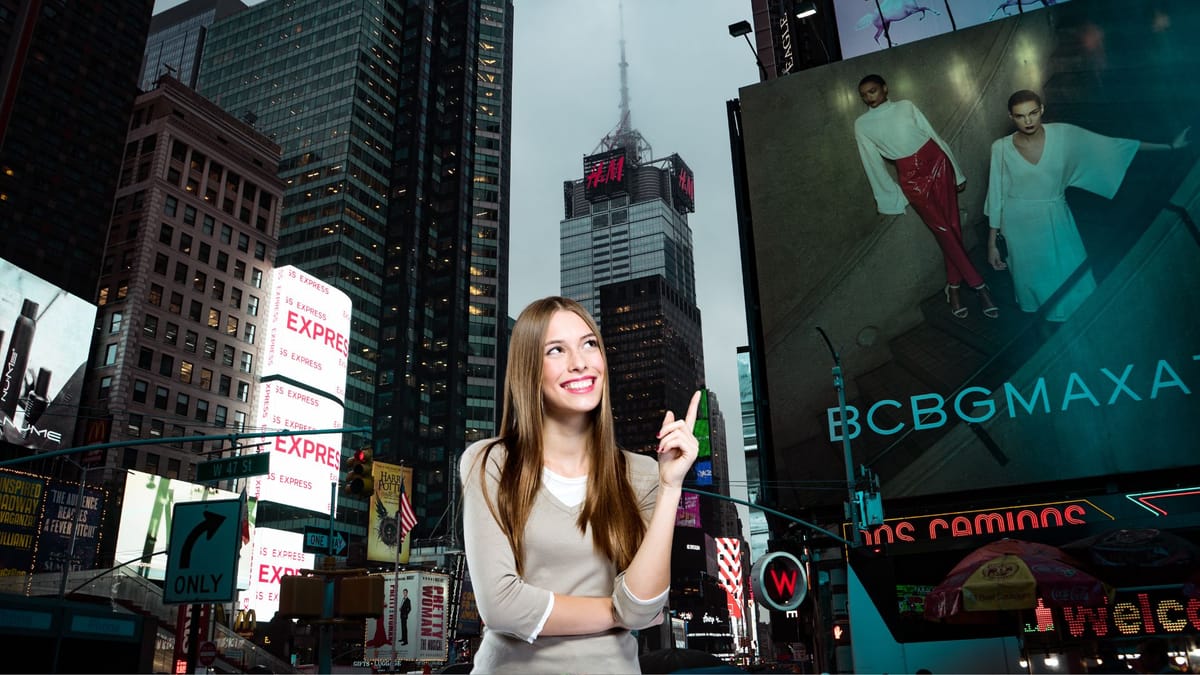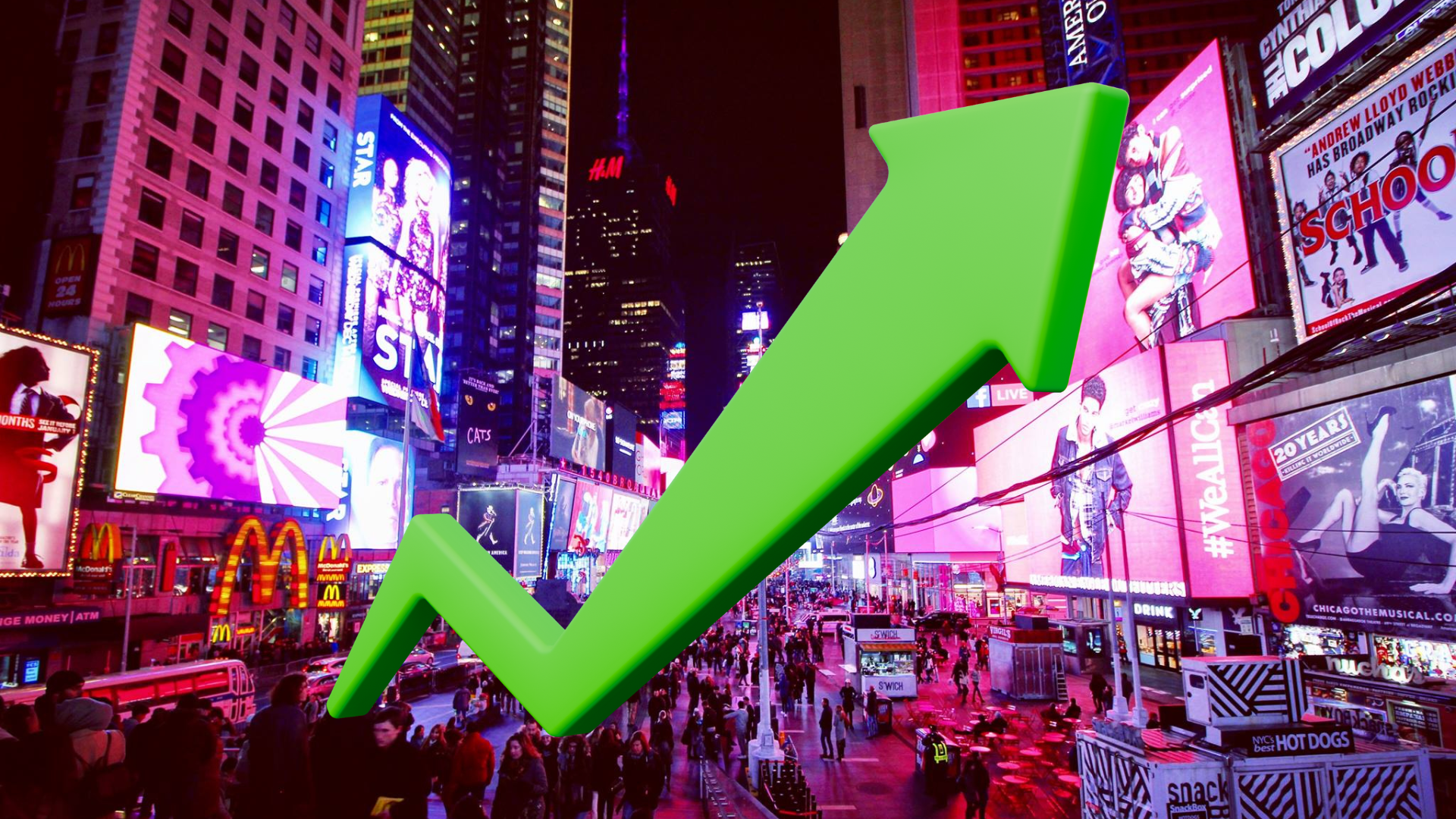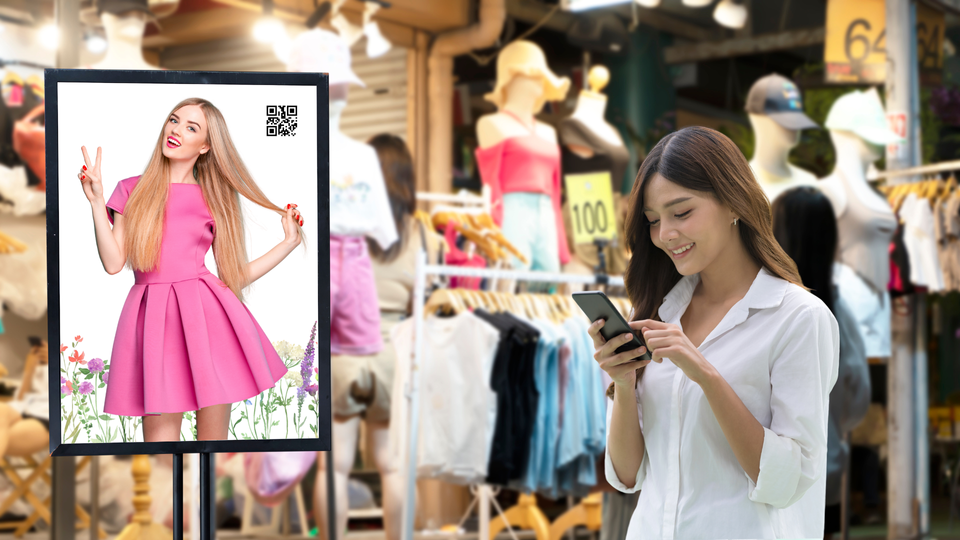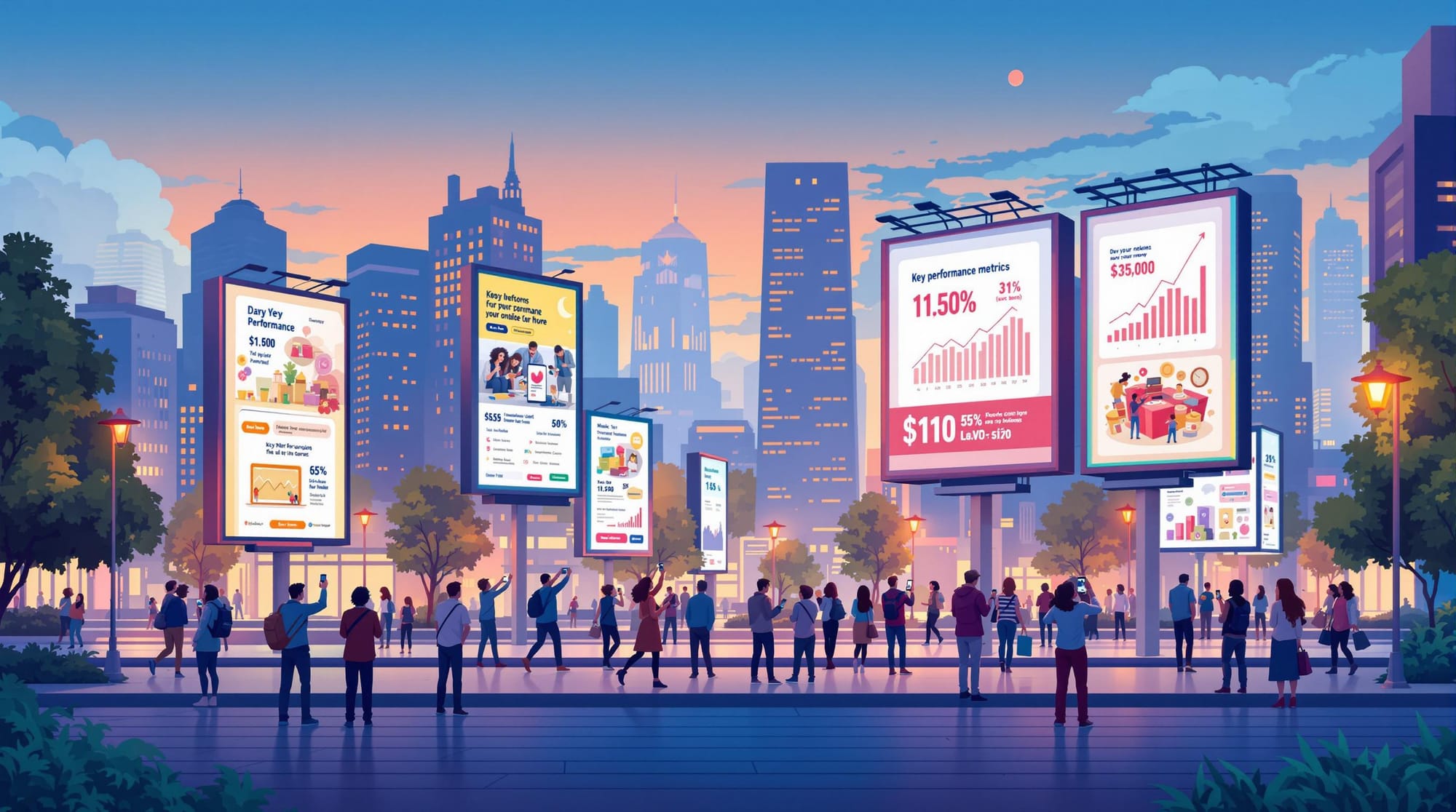Interactive DOOH: Common Questions Answered
Explore how interactive DOOH transforms advertising with real-time engagement, innovative technology, and measurable outcomes.

Interactive DOOH (Digital Out-of-Home) advertising turns traditional billboards into dynamic, two-way experiences. It uses technologies like touchscreens, motion sensors, and mobile integration to engage audiences directly. Here’s a quick breakdown of what you need to know:
-
What is Interactive DOOH?
It’s a digital advertising method that encourages audience interaction through tools like QR codes, AI, and motion sensors. -
Why Use Interactive DOOH?
- 82% ad recall rate
- Boosts audience engagement by 66%
- Expected to make up 45% of OOH ad spend by 2027
-
How Does It Work?
- Hardware: LED/LCD screens, media players, IoT sensors
- Software: Real-time analytics, content management systems
- Mobile Integration: QR codes, NFC, geofencing
-
Key Benefits:
- Longer engagement times
- Real-time content updates
- Precise performance tracking
Interactive DOOH campaigns, like British Airways’ flight tracking billboard or Nike’s 3D Air Max ad, show how combining creativity with technology can drive results. Whether it’s boosting brand awareness or increasing foot traffic, this approach makes ads more engaging and measurable.
Make your Outdoor Advertising Interactive
Technology Behind Interactive DOOH
Interactive DOOH (Digital Out-of-Home) thrives on a smooth combination of hardware, software, and mobile technologies working together.
Required Hardware
At the core of interactive DOOH are commercial-grade digital displays built for 24/7 use across different environments. The two primary types of displays are:
| Display Type | Benefits | Ideal Use Cases |
|---|---|---|
| LED Screens | Bright, energy-efficient, visible even in daylight | Outdoor setups, large displays |
| LCD Screens | Affordable, sharp image quality | Indoor spaces, smaller screens |
Media players act as the system's "brain." These can range from high-performance media boxes to budget-friendly media sticks or even all-in-one displays with built-in players. Many modern setups also incorporate IoT sensors and 5G technology for real-time responsiveness and data exchange.
While reliable hardware is essential, it’s the software that enables dynamic, real-time interactions.
Software Systems
Interactive DOOH demands software that can handle complex tasks. Key features include:
- A content management system (CMS) for updating content dynamically
- Open APIs to allow third-party integrations
- Strong security protocols to safeguard user data
- Real-time analytics to track and optimize campaign performance
According to research, 81% of marketers believe interactive content grabs consumer attention more effectively than static displays [4]. For example, these systems can adapt content in real-time based on triggers like weather changes or audience demographics.
Mobile connectivity takes these experiences to the next level.
Mobile Connection Methods
Mobile technology enhances DOOH campaigns by creating more personalized and engaging experiences. Popular connection methods include:
| Connection Method | Purpose | Effectiveness |
|---|---|---|
| QR Codes | Quick access to content | 74% of users take action after scanning |
| NFC Technology | Touchless, seamless interactions | Simplifies mobile engagement |
| Geofencing | Targets users based on location | Boosts engagement by 46% |
For instance, foodora in Germany ran a campaign that paired DOOH screens with mobile targeting. By triggering mobile ads when users were near the displays, the campaign delivered 107,000 ads and achieved one million impressions [5].
Another standout example is Samsung's Galaxy S21 campaign in Texas. By combining programmatic DOOH with mobile retargeting, the campaign saw a 1.75x increase in store visits [5]. Overall, integrating DOOH with mobile technology has been shown to extend campaign reach by up to 303% and significantly enhance engagement [5].
Audience Engagement Methods
Interactive DOOH turns passive viewers into active participants by using specific methods to encourage involvement and deliver measurable outcomes.
Increasing View Time
Adding interactive features significantly boosts how long people engage with content. For example, interactive video ads are watched 47% longer than non-interactive ones [4]. When viewers actively participate, their engagement naturally increases. Here are some key features and their effects:
| Feature | Impact | Best Practice |
|---|---|---|
| Touch Interactions | 66% more engagement | Position screens at eye level |
| Motion Sensors | 81% better attention capture | Place in high-traffic locations |
| Gamification | 79% better brand recall | Use simple, easy mechanics |
These features not only boost engagement but also allow for more precise and relevant messaging.
Content Targeting
Real-time data, like weather, time of day, or local events, helps tailor messages to fit the audience's current context. Dynamic creative elements make it possible to adjust campaigns instantly, ensuring the content feels timely and personal.
Performance Tracking
Interactive DOOH campaigns offer clear ways to measure success, including:
- Direct engagement: Metrics like QR code scans and touch interactions show immediate audience reactions.
- Cross-channel impact: Track website visits, app downloads, or social media interactions to measure digital effects.
- Location-based data: Store visits and dwell times reveal physical outcomes tied to the campaign.
These insights help fine-tune strategies, ensuring continuous improvement for future campaigns.
Successful Campaign Examples
Industry Examples
Nike's Air Max campaign in Tokyo grabbed attention with a 3D digital billboard featuring an opening shoebox that revealed various Air Max designs. Meanwhile, the NBA celebrated its 75th anniversary playoffs by integrating local game countdowns, live scores, and real-time fan tweets. This approach led to a 25% increase in tune-in intent and a 7% boost in brand awareness [7]. These campaigns showcase how creative strategies can deliver measurable impact.
Results and Numbers
Interactive DOOH campaigns have shown strong, measurable outcomes:
| Brand | Campaign Results | Key Metrics |
|---|---|---|
| Church's Texas Chicken® | 19.6M impressions | 12.2% store conversion rate |
| Betterment | 65% brand awareness boost | 117% increase in account intent |
| Mad Mex | 2.9M consumer reach | 9% sales increase |
| DoorDash | 6% Dasher signup intent | 22% work consideration boost |
"To be truly unforgettable, every campaign should be tailored to a brand's unique goals, whether it's driving foot traffic, building brand awareness, or sparking a conversation." – Hannah Lyder, vistarmedia.com [7]
Success Guidelines
These campaigns underline specific tactics that can lead to success in interactive DOOH:
-
Weather-Based Targeting
Guinness's "Brewery of Meteorology" campaign used real-time weather data to encourage pub visits and increase sales [7]. -
Location Intelligence
Travel Texas's "Let's Texas" campaign strategically placed ads that made viewers three times more likely to plan a trip to Texas [7]. -
Dynamic Content Integration
Michael Kors Jewelry ran a campaign in Germany that used targeted messaging, earning over 14 million impressions and increasing brand awareness by 13% in Hamburg and 39% in Berlin [8].
These examples prove that combining creativity with real-time data and dynamic content can create highly engaging and effective campaigns. The secret lies in delivering content that aligns with the audience's context and expectations while leveraging actionable insights to optimize results.
Common Issues and Solutions
Setup and Maintenance
Interactive DOOH often faces technical problems, like unstable networks that can disrupt performance. For critical installations, opt for wired connections to reduce disruptions. Older screens may also require adjustments to ensure the content displays correctly. To maintain consistent visuals across various screens, plan your content carefully.
Here’s a quick guide to handling common technical issues:
| Component | Common Issue | Recommended Solution |
|---|---|---|
| Network | Connection instability | Use wired connections and set up redundant systems |
| Hardware | Display compatibility | Test content on target screens before deployment |
| Software | Access management | Organize device groups with clear hierarchies |
| Content | Resource changes | Document processes to ensure smooth knowledge transfer |
Addressing these technical issues helps you focus on larger concerns, such as protecting user data.
Data Protection
Data protection is a key concern for interactive DOOH, especially when audience engagement involves collecting information. Advertisers need to strike a balance between offering engaging experiences and safeguarding privacy. For example:
- McDonald’s uses weather-triggered DOOH displays to promote menu items based on current conditions, without collecting personal data [9].
- Nike’s "Unlimited Stadium" campaign in Manila featured LED screens displaying runner avatars while ensuring user privacy [9].
Clear communication about data usage builds trust. Brands should explain how they handle data and offer audiences control over their information.
Performance Measurement
Measuring the success of DOOH campaigns requires advanced tools. Modern platforms combine multiple data sources to provide detailed performance insights. For instance, DOOH spending surged from $182 million in 2012 to $750 million in 2022 [10]. Computer vision technology now achieves over 90% accuracy in counting audience exposure [11]. A great example is MOBSTA’s campaign for Michael Kors Jewelry, which tracked brand awareness increases of 13% in Hamburg and 39% in Berlin [8].
To assess campaign performance effectively, focus on these areas:
- Audience Tracking: Use tools like computer vision and mobile data to measure actual views.
- Engagement Metrics: Track interaction rates via QR codes and unique URLs.
- Conversion Attribution: Link offline displays to online actions for a complete picture.
"Understanding performance is about knowing where your creative was seen, when it was seen and who it was seen by. Measuring success is about knowing whether you've achieved what you set out to do, and it's not possible to do that without maintaining a clear vision throughout." – Clear Channel [10]
Key Points Summary
Interactive DOOH (Digital Out-of-Home) advertising has turned outdoor ads into a measurable and engaging platform. Research highlights that interactive content boosts engagement by 66% [2], and the channel achieves an impressive 82% ad recall rate [1]. In 2023, DOOH stood out as the fastest-growing advertising channel, with a growth rate of 24.2% [1].
Essential Components for Interactive DOOH Success
| Component | Key Consideration | Impact |
|---|---|---|
| Technology Integration | Sensors, cameras, QR codes | Delivers immersive experiences |
| Content Strategy | Dynamic, personalized content | Adapts to real-time conditions |
| Mobile Integration | Cross-channel activation | Facilitates audience retargeting |
| Performance Tracking | Attribution and analytics | Tracks ROI effectively |
These elements lay the groundwork for creating impactful campaigns.
Proven Strategies for Maximizing Campaigns
-
Cross-Channel Integration
Use geo-fencing to reconnect with DOOH audiences and align campaigns with mobile activations. This ensures smooth retargeting opportunities [6]. -
Dynamic Content Delivery
Update content in real time based on factors like weather or local events. This keeps messaging timely and relevant [12]. -
Interactive Elements
Add features such as touchscreens, motion sensors, or augmented reality to create engaging and memorable user experiences [3].
Investing in OOH alongside digital and TV channels can increase ROI by up to 27% [13]. The focus should be on creating campaigns that encourage active viewer participation, backed by clear measurement strategies to evaluate success.





